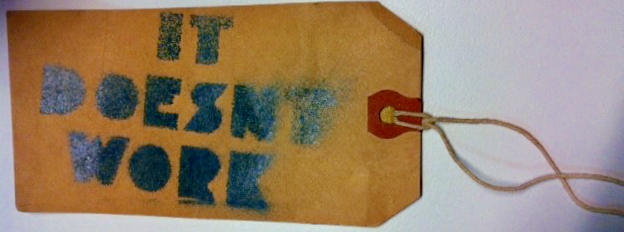Was kann man tun, wenn es mal nicht funktioniert?
Amos Vogel, Marcia Vogel und Jack Goelman über die Vorführungen im Cinema 16. Transkription eines Gesprächs in Paul Cronins Dokumentation Film as a Subversive Art: Amos Vogel and Cinema 16 (ab Minute 20).
Amos Vogel: Die regelmäßigen Vorstellungen fanden im Auditorium der Modeindustrie statt, das 1600 Sitzplätze hatte.
Marcia Vogel: Highschool Needle Trades. Es scheint in einem viel besserem Zustand zu sein als damals.
Jack Goelman: Das Auditorium war Teil der Central Needle Trade High School, der Name wurde inzwischen geändert, damals war es die Fashion Industries High School. Im Grunde ist es der gleiche Saal mit einigen strukturellen Unterschieden, mit Zubauten und Rückbauten…
Amos Vogel: Das ist der Ort, an dem wir unsere Cinema 16-Vorführungen über einen Zeitraum von etwa 15 Jahren hatten. Wir haben hier 1948 angefangen, vorher waren wir in verschiedenen anderen Räumen, aber das hier wurde der zentrale Ort, an dem wir unsere Filme zeigten. Es waren jedesmal 1600 Leute in einer Vorstellung, wir hatten zwei Vorstellungen an einem Abend, um 19:15 und um 21:30.
Jack Goelman: Der Weg, um in den Projektionsraum zu gelangen, verlief hier so: man ging durch diese Türen hinaus, musste über die Treppe in die nächste Etage hinauf laufen und den Flur entlang bis zu der Tür gehen, hinter der sich der Projektionsraum befand. Aber Amos hat in seiner Weisheit dafür gesorgt, dass wir eine Gegensprechanlage hatten, mit der wir mit dem Filmvorführer sprechen konnten. Allerdings bestand dabei eine Gefahr: wenn es sich um einen Stummfilm handelte und wir mit dem Vorführer sprachen, konnten uns alle hören. Also bauten wir noch etwas anderes auf, eine Signalanlage mit einem Summton, den wir sehr leise bedienen konnten: einmal summen bedeutete – Ton lauter drehen, zweimal bedeutete – Ton leiser stellen, dreimal bedeutete – sofort auf die Leinwand schauen, viermal bedeutete – das Bild ist unscharf, und fünfmal bedeutete – du bist neben der Leinwand.
Marcia Vogel: So habt ihr euch also beholfen.
Jack Goelman: Wir haben uns immer so beholfen. Wir haben die Anlage getestet, wir hatten Extra-Batterien, alles, ein komplettes Sicherheits-System, eine volle Rückendeckung, und wenn das einmal nicht klappte, weil es nicht funktionierte, dann musste man sehr schnell und leise die Treppe hinauflaufen…

What could you do if it doesn’t work? Amos Vogel, Marcia Vogel and Jack Goelman on the projections of cinema 16. Transcript of a conversation in Paul Cronin’s documentary Film as a Subversive Art: Amos Vogel and Cinema 16 (20 minutes onwards).
Amos Vogel: The regular performances took place in the Fashion Industries Auditorium which had 1600 seats.
Marcia Vogel: Highscool Needle Trades. It seems in much better condition than it was when we were here.
Jack Goelman: The auditorium was part of the Central Needle Trade High School, the name has been changed now, it was the Fashion Industries High School. Basically it is the same auditorium with structural differences, ad-ons and substractions…
Amos Vogel: This is were we had our Cinema 16 screenings for a period of about 15 years. Here we started in 1948, we have been in different places before that, but this became the main place where we showed our films and there were 1600 people in one show, we had two shows in one evening 7:15 and 9:30.
Jack Goelman: The way to enter the projection room was here by going out through these doors, finding the staircase, running up to the next floor and running along the hallway to the doorway where the projection was. However, Amos, in his wisdom, established the fact that we had an intercom with which we could speak to the projectionist. However there was a danger in that if it was a silent film and we spoke to the projectionist everybody would here us. So we rigged up another thing, an auxiliary help, a buzzer system which we buzzed very low: one meant – put the sound up, two meant – lower the sound, three meant – look at the screen immediately, four meant – you’re out of focus, and five meant – you’re off the screen.
Marcia Vogel: So you rigged it up.
Jack Goelman: We rigged it up every time. We tested it, we had extra batteries, everything, we had a fail safe system, a full back-up, and if we couldn’t do that, if it didn’t work, than you ran up the stairs very quickly and quietly…